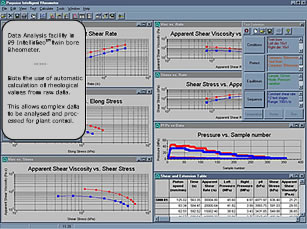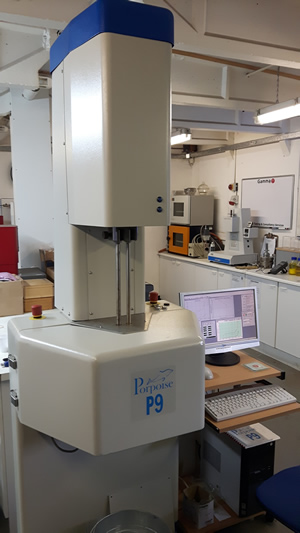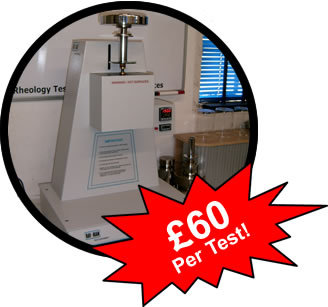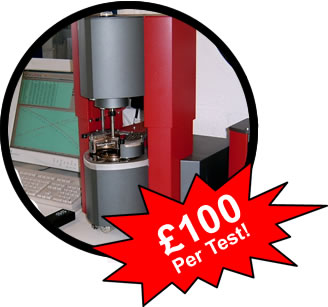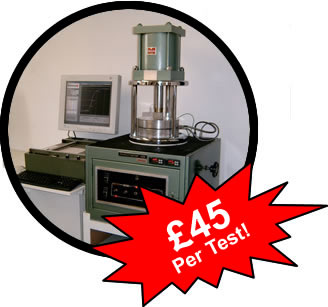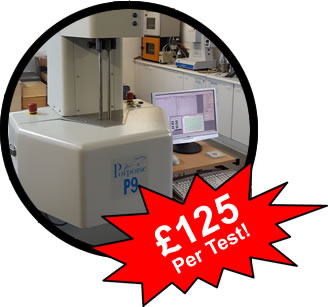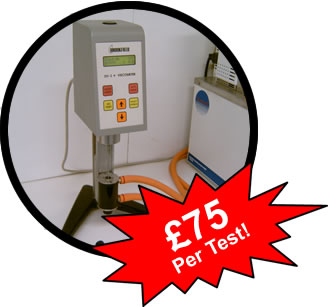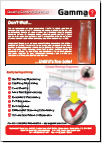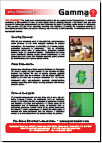 |
Gammadot
Rheology Testing & Consultancy Services
Unit
5C, Leaton Industrial Estate, Bomere Heath. Shrewsbury. Shropshire.
SY4 3AP. UK
Tel: +44 (0)1939 291677 ...Email: enquiries@gammadot.com
|
| |
Gammadot
Rheology Bi-Annual Newsletter - September 2017 |
Brand New Porpoise P9 Capillary Rheometer Commissioned
Gammadot
Rheology has recently commissioned a brand new state of
the art twin bore capillary rheometer supplied by Molecular
Control Systems Ltd.
The P9 IntelliRheo™ is one of the most technically
advanced laboratory capillary rheometers for the determination
of the flow behavior of a wide range of materials with all
the benefits of a twin bore system. The computer controlled
instrument offers testing abilities to measure shear viscosity,
extensional viscosity, wall slip, melt fracture and rupture
with a variety of dies and accessories.
The
IntelliRheo™ software offers standard test control
functionalities as well as scientific evaluation capabilities
for a better understanding of the data. Its ergonomic design
allows easy access and experimentation.
|
|
| |
|
FOCUS
ON: Oscillatory Rheometry & Quality Control
The
controlling factor in all polymer conversion processes
is the material's rheological behaviour - if you can't
deform & make the material flow, you can't process
it! The rheological response of a polymer melt is also
highly sensitive to material structure. A rotational rheometer
in oscillation mode (Oscillatory Rheometry), can detect
discrete changes in structural properties, therefore affording
a precise & accurate method of providing quality control
for all aspects of the process. Whether it be screening
incoming raw materials to discriminate batch to batch
variance, optimising the conversion process through minimising
the effects of thermal & shear history, or determining
the cause of degradation in failed components, oscillatory
rheometry can provide this information in a fast &
reproducible manner.
As
mentioned, Oscillatory rheometry measurements are
made utilising a rotational rheometer. This type
of rheometer is an extremely sensitive, yet robust
bench top instrument which is available in a number
of machine configurations. The measurement system
of the instrument is modular and therefore a wide
range of test parameters can be derived in conjunction
with the use of either plate / plate, cone &
plate or coaxial cylinder systems. |
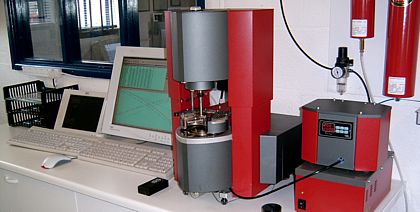 |
Some
examples of the type data that can be produced on the instrument
and their applications are demonstrated below:
Simple
'Go / No Go' quality control programmes
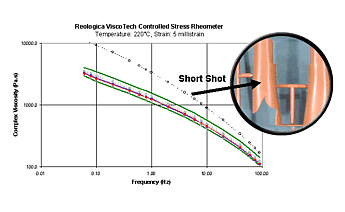 |
Controlling
quality of incoming batches of material is critical
to maintaining an optimised conversion process and
minimising reject rates. The graph on the left demonstrates
a simple 'Go / No Go' quality control programme
set up for an automotive components moulder who
operated a 'just in time' manufacturing regime.
The company had been experiencing problems with
variation in the properties of supplied batches
of Polypropylene, evident in fluctuating levels
of product reject rates - which threatened planned
delivery schedules. By characterising samples taken
from 'Good' & 'Bad' batches of material a simple
'process window' (the limits of which are indicated
by the green curves on the graph), was compiled
against which future batches could be compared -
enabling any incoming materials that fell outside
of the window to be rejected before entering the
production line.
Application
of Rheology to Failure Analysis |
Another
major application of oscillatory rheometry is the
support of failure analysis projects. The slide
on the right displays data produced as part of one
such project, carried out for an electrical connectors
manufacturer. Problems arose with a particular product
which had a brass fitting pressed into a central
boss within the moulding. This product was sourced
from two different manufacturing facilities - one
in Bulgaria which produced mouldings with no problems
and one in Poland which was producing components
that cracked upon pressing the brass insert into
position. The connector was moulded out of a glass-filled
PolyButylene Terephthalate (PBT) grade, a semi-crystalline,
hygroscopic (moisture sensitive) material. Sections
removed from both 'good' and failed components were
rheologically characterised and it could be seen
there was almost a full (log) decade drop in complex
viscosity across the measured frequency range between
the samples. This considerable decrease indicated
there had been a sharp reduction in molecular weight
due to degradation - chain scission probably being
a result of inadequate pre-process drying. |
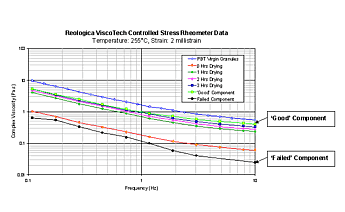 |
To confirm this theory, test specimens were injection
moulded after zero, one, two & three hours drying
in a vacuum oven @ a temperature of 135°C. Sections
of the dried mouldings and virgin granules were
measured and it could be seen that the viscosity
response of the undried (zero hours) moulding lays
closest to the failed sample's viscosity curve.
As predicted, as drying time was increased the level
of degradation decreased demonstrated by an increased
retention of properties. At the optimised drying
time for PBT of 3 hours @ 135°C it could be
seen the viscosity had risen to a level comparable
to that of the 'good' sample although interestingly,
after only one hours drying,
properties increased to a similar level.
|
Cure
Kinetics of Thermosetting Materials
 |
Due to the modular nature of the rotational rheometer
measurement system, disposable plate / plate systems
can be used to perform tests on curing and/or corrosive
materials. Measurements are usually carried out
either isothermally at fixed strain & frequency
as a function time (Isothermal cure), or fixed strain
& frequency as a function of temperature, (reactive
viscosity measurements). The plot to the left depicts
the viscosity responses of an NBR rubber compound
as a function of different heating rates, at 3 different
frequencies. Running as a function of temperature
in cooling mode is also excellent at determining
phase transitions in hot melt adhesives and investigating
the effect of changing ingredient ratios in compound
trials.
|
Control
software for modern rotational rheometers are exceptionally
versatile. A useful function of software is the ability
to 'string' individual test programmes into a project
'macro'. The graph on the right is an example of this.
A manufacturer of products for the offshore oil industry
was encapsulating components in a large volume of
Polyurethane, for use in offshore applications. The
cured resin was required to reach a specific modulus
to ensure integrity of the moulding at the pressures
experienced in deep sea conditions. Full cure of the
moulding was not reached until almost 24 hours after
mixing and casting, and the cure kinetics passed through
three distinct phases: an initial exothermic reaction
which raised the temperature of the casting from 20°C
to 130°C, an hour at a constant 130°C (a result
of adiabatic heating), followed by an 18 hour slow
cooling phase.
This was easily replicated by using three test templates
joined together in a project macro. All templates
used the same fixed frequency & strain amplitude
with the first programme running a heating ramp from
20°C to 130°C @ a heating rate of 20°C/min
(to replicate the heat generated during the initial
exothermic reaction). The second programme was an
isothermal measurement @ 130°C for one hour, (simulating
adiabatic heating conditions), and the third programme
an extremely slow cooling ramp from 130°C to 20°C
over 18 hours (-0.102°C/min). |
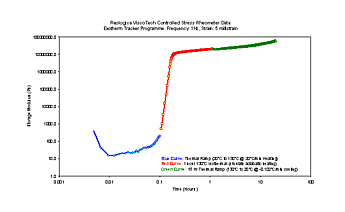 |
|
In addition to the small cross section of test programmes highlighted
above, the instrument is able to determine: thermal degradation
through melt stability studies, yield stress analysis, creep /
creep recovery and other standard rheology / viscometry techniques,
making the rotational rheometer an intrinsic part of a modern
day laboratories characterisation suite. Hopefully this short
piece has given an insight into the value of utilising controlled
stress rheometry in the solution of a variety of quality control
issues affecting processing, ranging from pre-process discrimination
of raw material to determining likely cause of failure in failed
products. Why don't you give Gammadot Rheology a call and discuss
your quality control needs today?
|
Back
to Top
Key
Gammadot Test Services
Melt
Flow Rate
|
|
Rotational
Rheometry |
| |
|
|
|
Melt
Flow Rate (Index) / Melt Volume Rate - MFR
(MFI) / MVR to ISO standard 1133 or ASTM D1238. Full suite
of weights and both standard and half sized capillary dies. |
|
Rotational
Rheometry - Shear viscosity
versus shear rate / Time / Temperature • Oscillatory
Rheometry as a function of Frequency / Time / Temperature
• Cure Kinetics / Melt Stability / Thermal Degradation
Studies
to ASTM standard D4440. |
ODR
Rubber Rheometry |
|
Capillary
Rheometry |
| |
|
|
|
Rubber
Cure Rheometry - With
uprated temperature control and datalogging system. Cure Kinetics
to ISO standard 3417 or ASTM 2084. |
|
Capillary
Rheometry - Shear viscosity as a function of shear
rate • Extensional viscosity as a function of extension
rate • Melt Density to ISO standard 11443 or ASTM D3835. |
P.v.T.
Behaviour |
|
Brookfield
Viscometry |
| |
|
|
|
High
Pressure Dilatometry (PvT Behaviour) - Specific Volume
or Density as a function of temperature & pressure. |
|
Brookfield
Viscometry - LV & RV viscometer ranges available
• Full range of RV / LV spindles plus Small Sample Adaptor
(SSA) • UL Adaptor for accurate low viscosity measurements. |
Check
out our other testing services too - A variety of thermal
& mechanical testing methods are available on request.
Also, further savings can be made with volume test discounts:
6 - 10 tests = 10% discount, 11 to 15 tests = 15% discount
& 16+ tests = 25% discount!
Finally, don't forget our one-stop material characterisation
for flow simulation services - providing a complete profile
of material data for Autodesk Moldflow, Moldex
3D & Sigmasoft 3D simulation
software packages - Thermoplastic, Thermoset & Elastomer. |
|
Back
to Top
Gammadot
Service Flyer Download
|
|
For
further information about Gammadot Rheology's testing & consultancy
services, or if you have a specific problem / testing requirement
which you would like Gammadot to provide a solution to, please
contact us using the details at the top of the page or via the
enquiry form HERE.
You
have received this newsletter as a past customer, contact or because
Gammadot Rheology believes you are a company which may benefit
from our services, If you DO NOT
wish to receive any further email correspondence from Gammadot,
please reply to this message with the word REMOVE
in the subject bar, and we apologise for any inconvenience caused.
|

|

